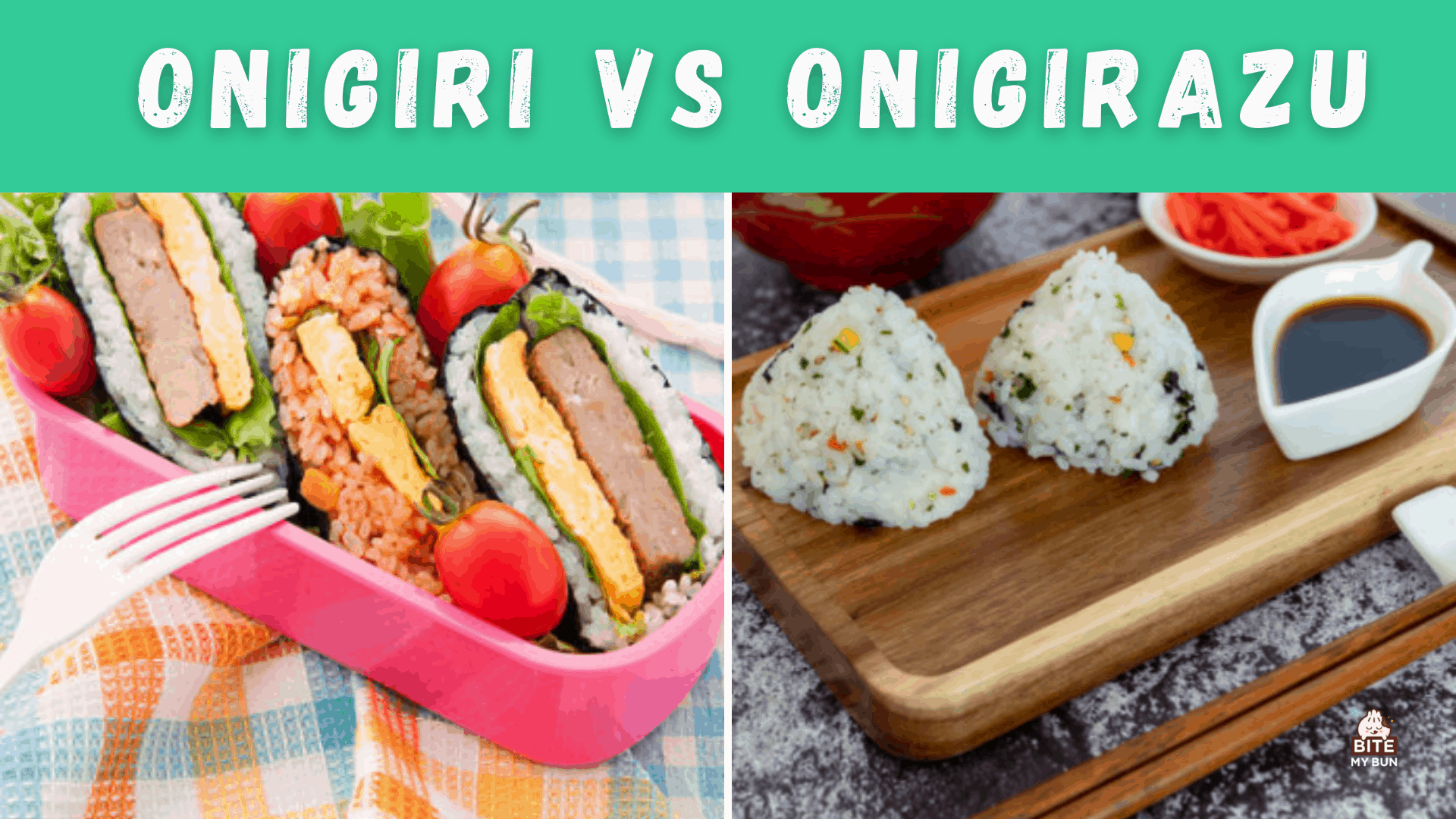Onigiri vs onigirazu | How they differ and why you want to try them both
Onigiri (also known as omusubi, nigirishimi or just plain Japanese rice ball) and onigirazu serve similar purposes but are somewhat different.
Onigiri is a triangular or round ball of white rice wrapped in nori seaweed. Onigirazu is nori-wrapped rice, but more like sushi, often called “sushi sandwich.” These two foods are cooked differently, contain different ingredients, and come in different forms but are both meant as a snack on the go.
I’ll tell you the exact differences and how you can enjoy these sushi-like creations.


Check out our new cookbook
Bitemybun's family recipes with complete meal planner and recipe guide.
Try it out for free with Kindle Unlimited:
Read for freeIn this post we'll cover:
Onigiri
As onigiri is a very popular food, a trend even, in Japan, it can be bought from almost every convenience store.
In addition, some restaurants provide onigiri as a take-out choice (in bento boxes), since it’s easy to eat on the road. It’s usually very affordable.
Taking into consideration that the rice isn’t cooked in the same way as the rice is cooked for sushi, onigiri is very easily preserved for quite some time (a couple of days).
History
It is quite interesting how, when onigiri was invented (around the 17th century), it was necessary to find a way to preserve this food (there were no refrigerators).
Therefore, they used natural preservatives such as salt or vinegar to keep the rice in a compact form and preserved.
The first appearances of this food are during the 17th century. This food is actually named tonjiki in diaries that date even earlier than the 17th century.
This food is seen at picnics, even at war. Soldiers are known to take with them small triangular balls or rice as quick snacks before the war.
It’s unclear when onigiri was actually invented, but it was in Japan and started appearing during the Kamakura or Edo period.
Onigirazu
Onigirazu, also known as the “sushi sandwich”, is quite a unique food because it combines Western cuisine elements (sandwich) with Japanese elements (steamed rice, seaweed, and a variety of fish).
In order to prepare this sandwich, the rice needs to be salted without necessarily seasoning it. Since it is larger than the onigiri, you also need larger amounts of fillings, fish or meat, and more seaweed.
Where onigiri only has a tiny amount of filling in the center of the rice ball, onigirazu has the filling throughout, more like toppings on a sandwich.
Onigirazu is a more modern option and is considered to be an evolved version of onigiri.
Therefore, it combines both traditional elements (onigiri), and modern elements (the concept of the sandwich).
In general, onigirazu is more complicated than onigiri. Take into consideration that every ingredient and filling is wrapped in seaweed hence, everything has to be in rather small portions and with a balanced taste.
It is quite interesting how onigirazu came into existence. It was first seen during the 1980s in the adult manga series “Cooking Papa”.
Onigirazu was modeled after the sandwiches the wife of the writer made, and soon they became very popular after a few large recipe sites in Japan picked it up from the manga books, and turned it into a real recipe.
Onigiri vs onigirazu: cooking, fillings, and ingredients
Let’s look at specific details that differentiate onigiri from onigirazu.
Preparing the rice
The most basic difference is the preparation and the cooking of the rice.
Onigiri rice is cooked plainly without any seasoning while the rice for onigirazu is cooked with salt, and sometimes with vinegar and/or sugar, like sushi rice.
Fillings
Second, since onigirazu is a sandwich, there are more options when it comes to the fillings. You can fill your onigirazu with:
- meat (spam is a popular option)
- fish
- eggs
- vegetables
- noodles
- wide range of sauces
Onigiri tends to be more simple with fillings, in part due to its relatively small size. The fillings mentioned below are the ones used more often when creating onigiri:
- salmon
- cod roe
- bonito flakes
- pickled plum
- and tuna and mayo is my favorite
Most popular
Third of all, onigirazu is generally more preferred than onigiri. Even though onigiri is the traditional and original one, onigirazu is the modern choice, that also serves better as a dish.
Therefore, people can eat it for lunch, brunch, dinner etc. Onigiri is usually an appetizer or a part of a dish.
Seaweed
Last but not least, it is important to mention that the seaweed used for both foods is very rich in minerals. If consumed in large amounts (too many onigirazus), it might upset our stomach, because of its large amount of iodine.
From this perspective, onigiri is safer for people that have hyperthyroidism.
Conclusion
Even though these two foods can sometimes be considered the same, many differences set them apart.
Nevertheless, make sure to try both the simpler (onigiri) and the more complicated choice (onigirazu)!
Here’s a recipe for Yaki onigiri, the perfect Japanese grilled rice ball snack for drinks
Check out our new cookbook
Bitemybun's family recipes with complete meal planner and recipe guide.
Try it out for free with Kindle Unlimited:
Read for freeJoost Nusselder, the founder of Bite My Bun is a content marketer, dad and loves trying out new food with Japanese food at the heart of his passion, and together with his team he's been creating in-depth blog articles since 2016 to help loyal readers with recipes and cooking tips.

